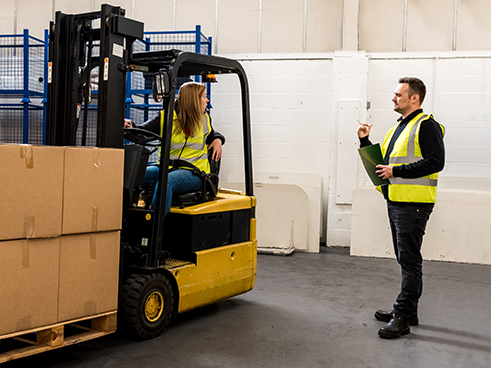 Stuart Taylor |
Stuart Taylor is Managing Director of Mentor FLT Training Limited, the UK's leading provider of training and associated services for all types of materials handling equipment and workplace transport.
A top priority for anyone managing forklift operations must be to uphold safety. But what does this look like day-to-day? Busy sites mean there is a lot to oversee, and it can be difficult to know where to begin - particularly if you haven't come from a background as a forklift operator.
It's vital that managers can spot bad practice and rectify it before it leads to an accident. Here are some of the most common examples to watch out for:
Poor observationsOne of the main causes of serious workplace accidents and fatalities is being hit by a moving vehicle. Check that operators carry out their all-round observations properly, every time, before they move their truck or the load, to ensure that they are aware of pedestrians or obstructions.
Unsafe load transportationInsecure loads, uneven weight distribution and overloading are all examples of so-called 'shortcuts' that can lead to lost loads and tip overs, with serious consequences. As well as watching out for these, managers should ensure that operators complete one manoeuvre at a time while carrying a load (i.e. turn, then lift; not turn and lift).
Inadequate pedestrian segregationPedestrians and forklifts must always remain a safe distance apart, especially in areas where they cannot be physically separated. Whether colleagues or visiting drivers, pedestrians should not be permitted to help with loading/unloading and should never try to steady a load.
Putting robust, reinforced Safe Systems of Work in place will help to maintain safe working distances. Communicate these systems to everyone who may need to access an area where forklifts operate, however rarely this may be. This includes staff, contractors, visitors and delivery drivers.
Poor visibility when operating a truckHigh loads can obscure the operators' view of their surroundings, increasing the risk of them colliding with other vehicles, pedestrians or racking. Make sure that operators are travelling with a clear view, so that they can stay alert to any surrounding risks. If their view is obscured by the load and they cannot travel in reverse, then they should use a banksman to guide them.
Not wearing seatbeltsIn the UK, the HSE is clear in its guidance: "Where restraining systems are fitted, they should be used." Forklift operators may prefer to not wear seatbelts but the fact is they significantly reduce the consequences of an accident. If the truck was to become unstable and tip over, a seatbelt stops the operator from being thrown from the cab or trying to escape, which can lead to them being trapped under the truck. Adding seatbelts to company policies makes their use mandatory on site and managers should reinforce this through regular monitoring, refresher training, on-site signage and the like.
Misusing equipment or using the wrong equipmentManagers should look out for cases where operators are using unsuitable equipment; for example, lifting colleagues using makeshift cages, rather than purpose-built work platform attachments or MEWPs. Also dangerous is using the right equipment but in ways it was not designed to be used, i.e. using lift trucks to push loads, rather than lift them. Ensure that operators have access to the correct equipment for the task and are properly trained to use it, to protect themselves and their colleagues.
 High loads can obscure the operators' view of their surroundings |
SpeedingTight deadlines and high demand can influence some operators to compromise on safety in an attempt to save time. But rushing comes at a high cost when it increases the risk of tip overs, collisions or lost loads. Check that operators are aware of speed limits on site and that they understand the need to stick to them at all times, regardless of any operational pressures.
Dismounting incorrectlyForklift operators can become complacent during mounting/dismounting, simply due to the frequency that this is done every day, and may be tempted to jump from the cab. But this increases the risk of slips and falls, and also adds additional distance between them and their cab, potentially putting them into the path of another vehicle. Take a look at the three points of contact rule for the safest way to enter/exit a lift truck.
These are just a few examples of the risks which your managers must target to help protect your team and your business. By regularly monitoring operations and making time for proper supervision, those overseeing forklift use can guard against unsafe practice, proactively rectifying any bad habits day-to-day.
If your managers and supervisors need additional guidance, there are specialist training courses available to provide the skills they need to meet their responsibilities and resolve any issues before they lead to costly accidents.